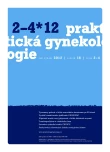Consultation as the main factor affecting the choice of way of using the combined hormonal contraception: comparison of the CHOICE study results
Authors:
Tomáš Fait
Authors‘ workplace:
Gynekologicko-porodnická klinika 1. LF UK a VFN Praha
Published in:
Prakt Gyn 2012; 16(2-4): 102-107
Category:
Contraception: Review Article
Overview
The CHOICE study undertaken in all 11 European countries has shown that, following provision of the proper instruction on all the ways of using combined hormonal contraception, an increasing preference for non-oral application systems has been observed. In all the countries included in the CHOICE study, the number of women, who would choose the vaginal ring, has significantly increased. Except for the Czech and Slovak republics the use of contraceptive patches has also increased. The increase in non-oral use is related to a higher age of patients, existence of long lasting relationship, higher education and anamnesis of unintended pregnancy. The study has proven a significant effect of receiving a proper instruction and consultation with a physician on the patient’s choice of contraception.
Key words:
combined oral contraceptive – COC – CHOICE Study – vaginal ring – contraceptive pill – contraceptive plaster
Sources
1. Kocourková J, Fait T. Induced abortions: Still important reproduction loss in the Czech Republic? Neuro Endocrinol Lett 2009; 30(1): 101–108.
2. Fait T. Antikoncepce. 2. vyd. Praha: Maxdorf 2012.
3. Fait T, Apetauer I. Význam konzultace při výběru kombinované hormonální antikoncepce – výsledky projektu CHOICE (Contraception Health Research Of Informed Choice Experience) v České a Slovenské republice. Čes Gynek 2011; 76(2): 140–144.
4. Fait T. Kritéria českých a slovenských žen při výběru kombinované hormonální antikoncepce. Čes Gynek 2011; 76(3): 190–193.
5. Fait T. Combined Hormone Contraceptive Choice Experience in Czech Republic. CEJMed 2011, 6(5): 582–587.
6. Gemzell-Danielsson K, Thunell L, Lindeberg M et al. Comprehensive counseling about combined hormonal contraceptives changes the choice of contraceptive methods: results of the CHOICE program in Sweden. Acta Obstet Gynecol Scand. 2011; 90(8): 869–877. Dostupný z WWW (DOI): http://doi: 10.1111/j.1600–0412.2011.01180.x. Epub 2011 Jun 20
7. Bitter J, Gemzell-Danielsson K, Roumen F. et al. The CHOICE study: Effect of counselling on the selection of combined hormonal contraceptive methods in 11 countries. Eur J Contracept Reprod Health Care 2012; 17(1): 65–78.
8. Bitzer J, Cupanik V, Fait T et al. Factors influencing women´s selection of contraceptive methods during counselling. Eur J Contraception Reprod Health Care 2012; 17(Suppl 1): S85-S86. Abstract P067.
9. Lete I, Doval JL, Pérez-Campos E et al. Factors affecting women‘s selection of a combined hormonal contraceptive method: the TEAM-06 Spanish cross-sectional study. Contraception 2007; 76(2): 77–83.
10. Saeed GA, Fakhar S, Rahim F, Tabassum S. Change in trend of contraceptive uptake-effect of educational leaflets and counseling. Contraception 2008; 77(5): 377–381.
11. Shunmann C, Glacier A. Specialist contraceptive counselling and provision after termination of pregnancy improves uptake of long-acting methods but does not prevent repeat abortion: a randomized trial. Hum Reprod 2006; 21(9): 2296–2303.
12. Langston AM, Rosario L, Westhoff CL. Structured contraceptive counseling – A randomized controlled trial. Patient Educ Couns 2010; 81(3): 362–367.
13. Skouby SO. Contraceptive use and behavior in the 21st century: a comprehensive study across five European countries. Eur J Contracept Reprod Health Care 2004; 9(2): 57–68.
14. Lopez LM, Steiner MJ, Grimes DA, Schulz KF. Strategies for communication contraceptive effectiveness. Cochrane Database Syst Rev 2008; 16(2): CD006964.
15. Urdl W, Apter D, Alperstein A. et al. Contraceptive efficacy, compliance and beyondfactors related to satisfaction with once-weekly transdermal compared with oral contraception. Eur J Obstet Gynecol Reprod Biol 2005, 121(2): 202–210.
Labels
Paediatric gynaecology Gynaecology and obstetrics Reproduction medicineArticle was published in
Practical Gynecology

2012 Issue 2-4
Most read in this issue
- Diagnosis and therapy of some extragenital forms of endometriosis
- How to behave when giving medical treatment to foreigners: pitfalls, findings and recommendations
- Ulipristal acetate: new antiretroviral drug in treatment of uterine fibroids
- Anorgasmia and frigidity
